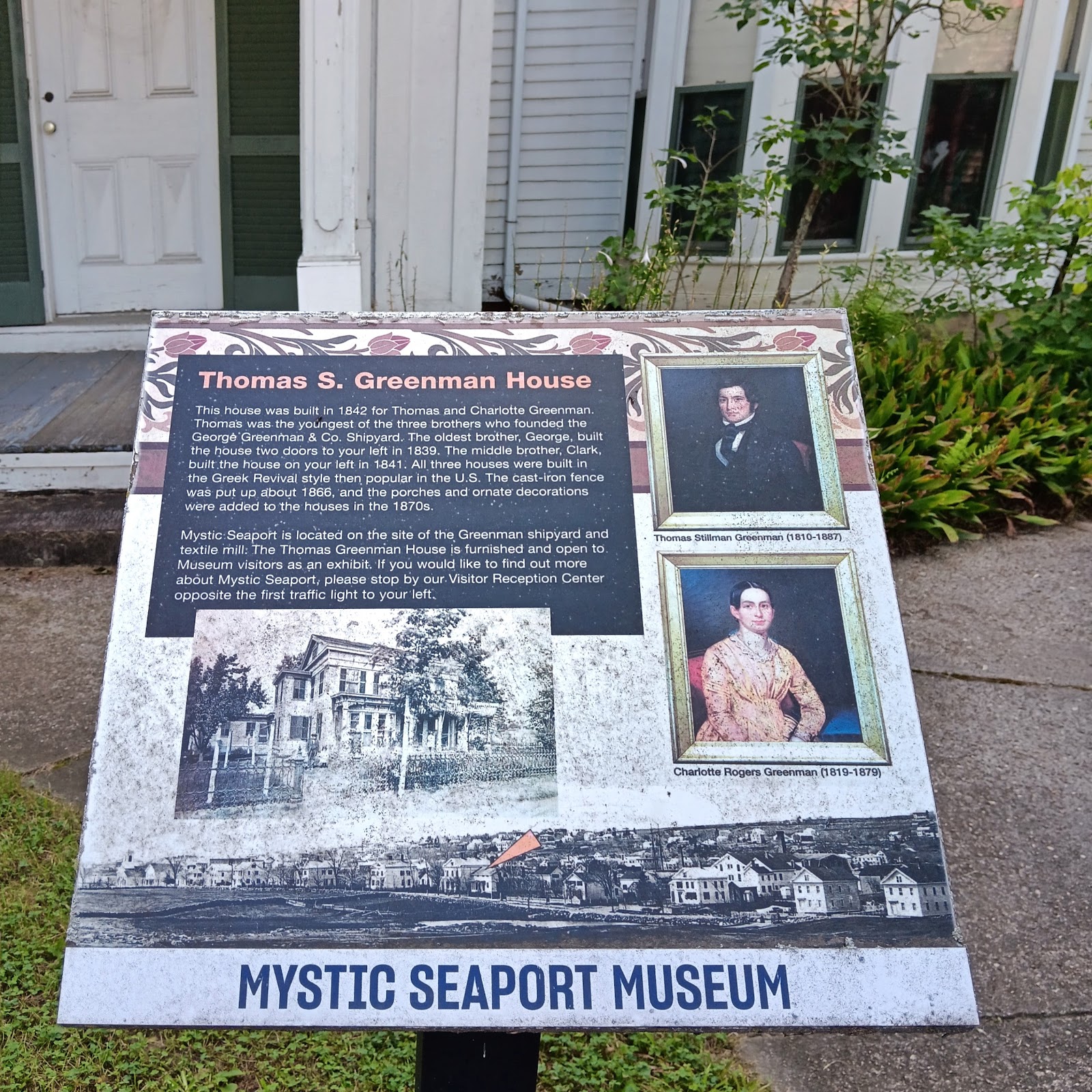Mystic Seaport Museum: Bonus Houses

I recently had an adventure in the Mystic / Lyme region of Connecticut and spent about a day and a half at Mystic Seaport Museum. This is the sixth post in a six-part miniseries about my visit. My last four posts covered Part 1 and Part 2 of “Seaport Village” along with the “Preservation Shipyard”, “Galleries”, and “Boats, Signs, & Shows”. In “Bonus Houses”, I look at four properties owned by the museum and visible from the street, and then give my conclusion to the series.
William Haynes House
This section of Mystic was the village of Greenmanville, so named for the wealthy Greenman family, not so unlike how my own town of Whitinsville was named for the Whitin family. The houses itself was named for a carpenter working for George Greenman and Company, and the 1850s building is currently used as museum offices. While Haynes worked with wood, other employees of the Greenman family worked in their textile mill, farms, and store.


George Greenman House
The oldest of the brothers was George Henry Greenman. In 1839, he and his wife Abigail “Abby” Chipman (a great name) had this house built. George’s two younger brothers, Clark and Thomas, lived with them until they got their own houses next door. Abigail must have been a woman of great patience. The houses match due to their Greek Revival style, but each house has a different paint job. The Greenman family made their money in the shipbuilding business, especially clippers, with George starting the firm George Greenman and Company. He later became president of Standard Machine Company in Mystic, which built machines for paper cutting and book binding.




Clark Greenman House
In 1841, two years after his older brother George built his house, Clark Greenman and his wife Harriet Almy Greenman had this house built next door. Its current bright yellow color was added in the 1870s. Like William Haynes House, it is currently use as offices at the museum. Besides involvement in local business, the family were active members of the Seventh-day Baptist Missionary Society. This Christian organization was formed to send missionaries around the world and to this day holds worship services on Saturdays instead of Sundays.




Thomas S. Greenman House
In 1842, three years after oldest brother George built his house and two years after middle brother Clark built his house next door, Thomas Stillman Greenman and his wife Charlotte Rogers Greenman had this house built in the same row. Today, this house allows visitors to go inside. The first floor is decorated to resemble the upper class parlors and dining rooms of the mid to late 19th century in New England. Like other houses from the time period that I have visited, the house featured design inspirations from East Asia, a black lacquered fireplace, also known as Japaning, and an overhead painted glass light in the atrium, and ceramic vases. More traditional European furniture and decor included the dining table and crystal chandelier, a curios table in the parlor, and portraits of the original owners.








Conclusion
With such a wide range of buildings, exhibits, shows, and interactives, Mystic Seaport Museum truly has something for the whole family. While I spent just under a day and a half at the museum, a visitor could easily dedicate three or four full days if they wanted to see all the shows, take all the tours, and ride all the bonus boats. The museum has done a lot of work in the ways of Diversity, Equity, and Inclusion (DEI) along with working on accessibility initiatives. Attractions with stair access only are marked with a stair icon on the map; unfortunately this includes major stops like Charles W. Morgan, Mystic Print Shop, and Shipcarver’s Shop. The museum had plenty of outside seating, but some buildings were dimly lit. I appreciated the misting station located near the Meeting House that allowed visitors to cool off during the hot day.
Because Mystic Seaport is an outdoor museum, its open hours vary greatly depending on time of year. When I went during peak summer season, the houses were open every day from 10:00 a.m. to 5:00 p.m., and the grounds closed at 6:00 p.m. Ticket pricing varies widely at $31 for General Admission, $29 for seniors over 65, $27 for youth 13-17, $23 for college students with valid ID, $21 for children ages 4 to 12, and $0 for children up to age 3, museum members, Mystic SeaPass members, New England Museum Association (NEMA) members (like me!), Council of American Maritime Museum (CAMM) members, active duty military in uniform, SNAP/EBT recipients, members of the Mashantucket and Eastern Pequot Tribal Nations with Tribal IDs, and people on their birthday with a valid ID or birth certificate. Several other discounts are available, and their official webpage lists most of them. Tickets are valid for two days within seven business days.
Abby Epplett’s Rating System
Experience: 9/10
Accessibility: 7/10